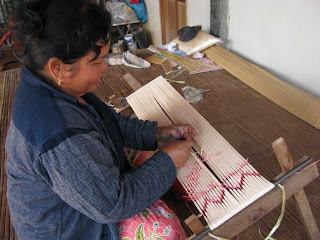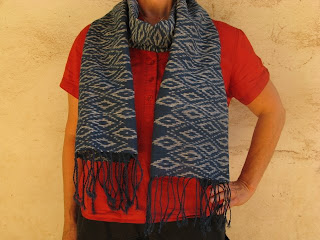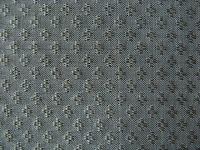 We came here in search of handwoven cotton khram (indigo) textiles, an art practiced for generations in this area. These luscious blues have been very popular at previous TAMMACHAT events; probably because so many of our customers have the same hair colour that I do -- although it would be a challenge to name any colouring that doesn't look great with one of the umpteen shades of blue that can result from this natural dye, depending on the fibre, the season, the method of processing and the number of dye baths. We've been told that even the time of day is a factor -- BTW, early morning is the preferred time to dye the yarns.
We came here in search of handwoven cotton khram (indigo) textiles, an art practiced for generations in this area. These luscious blues have been very popular at previous TAMMACHAT events; probably because so many of our customers have the same hair colour that I do -- although it would be a challenge to name any colouring that doesn't look great with one of the umpteen shades of blue that can result from this natural dye, depending on the fibre, the season, the method of processing and the number of dye baths. We've been told that even the time of day is a factor -- BTW, early morning is the preferred time to dye the yarns.I'm happy to report that our search has been very sucessful; we have not only found indigo products but we've found them made by women's groups in 2 different provinces and numerous districts, encompassing hundreds of kilometres, women and items!


Already on their way to Canada are some exceptional mudmee patterned indigo scarves. Mudmee, as some of you know, is a process of tyeing and dyeing the yarns before they are woven. These variegated yarns then line up on the loom, resulting in elaborate geometric, and sometimes figurative, patterns.


 We visited one weaving group on the banks of the Mekong, where we were able to see and photograph each step of this process. While we were there we hosted a luncheon get-together with the group, where much laughter as well as great food was shared. We especially enjoyed a hilarious lesson on the correct pronunciation of Mae Nam Khong (Mekong River in Thai) -- next time you see Ellen, ask for a demonstration.
We visited one weaving group on the banks of the Mekong, where we were able to see and photograph each step of this process. While we were there we hosted a luncheon get-together with the group, where much laughter as well as great food was shared. We especially enjoyed a hilarious lesson on the correct pronunciation of Mae Nam Khong (Mekong River in Thai) -- next time you see Ellen, ask for a demonstration.We rushed off from those visits in Ubon province to come north to Sakhon Nakhon, when we heard a provincial fair was in full swing where many weaving groups that specialize in indigo would be selling. Although we were invited to visit their villages, we settled on purchasing goods at the fair this year and have promised to return next year (prior to the fair's launch) to take them up on their hospitality and see first hand the work in progress.
We're sure that the many shades of indigo and the many styles of weaving that we're sending home today will make everyone an indigo fan.
Ellen has taken pictures of someone (?) wearing a selection of these wonderful cotton scarves with close-ups so you can see the woven patterns.




On a final note, a more personal anecdote: I was disappointed that, unlike in most other provincial capital towns, absolutely no one rents motorbikes here. I had hoped that we would have at least one day to toodle around and see the sights -- maybe have a serendipitous encounter with some weavers or ??? -- but without wheels it didn't seem possible. Anyway, having a little more time on our hands than anticipated, we returned to the fair where we saw a vendor who'd not been in her stall on our earlier visit. Not only did we find 2 more styles of scarves that we're sure will be a hit, but we also had a wonderful conversation and received another invitation to visit her home. Last but certainly not least, when she heard of my unrealized intention to rent a motorcycle, she offered me hers. After my 2 requisite polite declines, she was still insisting so I took her up on her offer, without so much as a baht (the Thai currency) or a passport as collateral. So...yesterday we had a fine time driving through the Phou Pan National Forest district and visiting the Phou Pan Palace. (Palaces are customary Thai tourist sites when there are no Royals in residence.)
 And finally, here is one of the many Thai peacocks we saw at the Royal Palace, strutting his stuff!
And finally, here is one of the many Thai peacocks we saw at the Royal Palace, strutting his stuff!Until next time,
Pii Plaa (aka Alleson)












